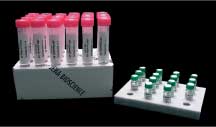Easy entry to fragment-based lead discovery (FBLD) by crystallographic screening:
A major challenge in drug discovery is the identification of chemical moieties that specifically interact with a particular protein target. Traditionally, this was addressed by High Throughput Screening (HTS) however, recently “Fragment Screening” has become increasingly popular. In a Fragment Screen a set of small molecules (“fragments”), typically with MW < 300 Da and with low affinities, are evaluated for specific interaction with the target.
Crystallography/X-ray diffraction shows not only whether a fragment binds to the protein but also where and how the binding occurs and is therefore the favored screening method. Hit-fragments are subsequently chemically modified in several optimization/screening cycles until a high affinity lead structure is obtained. Since such a fragmented approach allows screening of broader chemical space compared to large, distinct libraries, the hit rates of Fragment Screens are believed to be 10-1000x higher than those in traditional HTS[4].
The Frag Xtal Screen offers an easy entry to fragment-based lead discovery (FBLD) by crystallographic screening:
- 96 fragments
- High fragment solubility allows high soaking concentrations (> 90 mM; may depend on soaking conditions)
- In-house tests with high crystallographic hit rates
- Validated X-Ray hits for diverse target classes in the PDB
- Diverse and representative fragment library for large chemical space
- Straight-forward follow-up compounds available
For in vitro use only!
Shipping: shipped at ambient temperature
Storage Conditions: store in aluminum bag at -20 °C
Shelf Life: 12 months
Description:
The Frag Xtal Screen provides 96 different fragments. Two protein wells are spotted with 50 nmol fragment each while the third one is kept free. This allows to vary the stabilizing solution, e.g. the DMSO content.
Crystallographic screening and the structural data collected are the only reliable information to verify fragment binding for structure-based drug design. It was shown that the biochemical and biophysical assays routinely performed as prescreens show distinct hits with minimal overlap eliminating promising candidates and maybe focussing on the poor ones [1-3]. The Frag Xtal Screen is designed to directly collect structural data of protein crystals soaked with 96 different fragments.
Applications:
Fragment-based lead discovery (FBLD) by crystallographic screening
Protein surface mapping by crystallographic screening
Short Fragment Soaking Protocol:
1) Remove foil carefully
2) Add 30 μl crystallization buffer to the reservoir (manually or by robot)
3) Add 0.5 μl crystallization buffer on dried fragments (manually or by robot)
4) Add 1-2 crystals per drop
5) Seal the plate & incubate 1-48 h
6) Fish & cryo-cool at least one crystal per condition
The fragment screen was developed by Jena Bioscience in cooperation with the HZB MX-groupat BESSY II (AG Weiss) and the Institute of Pharmaceutical Chemistry, University of Marburg (AG Klebe).
Fragment Screening Poster MSDS Datasheet Screen Formulation
通过晶体筛选轻松进入基于片段的先导发现 (FBLD):
药物发现的一个主要挑战是识别与特定蛋白质靶标特异性相互作用的化学部分。传统上,这是通过高通量筛选 (HTS) 解决的,但是,最近“片段筛选”变得越来越流行。在片段筛选中,评估一组小分子(“片段”)(通常具有 MW < 300 Da 和低亲和力)与目标的特定相互作用。
晶体学/X 射线衍射不仅可以显示片段是否与蛋白质结合,还可以显示结合发生的位置和方式,因此是首选的筛选方法。随后在几个优化/筛选循环中对命中片段进行化学修饰,直到获得高亲和力的先导结构。由于与大型、独特的文库相比,这种碎片化方法允许筛选更广泛的化学空间,因此片段筛选的命中率被认为比传统 HTS 中的命中率高 10-1000 倍 [4]。
Frag Xtal Screen 通过晶体学筛选提供了一种轻松进入基于片段的先导发现 (FBLD) 的方法:
96个碎片
高片段溶解度允许高浸泡浓度(> 90 mM;可能取决于浸泡条件)
具有高晶体命中率的内部测试
针对 PDB 中不同目标类别的经过验证的 X 射线命中
用于大化学空间的多样化和有代表性的片段库
提供直接的后续化合物
仅供体外使用!
运输:在环境温度下运输
储存条件:-20°C 储存于铝袋中
保质期:12个月
描述:
Frag Xtal Screen 提供了 96 个不同的片段。两个蛋白质孔各有 50 nmol 片段,而第三个孔保持空闲。这允许改变稳定溶液,例如DMSO 的含量。
晶体筛选和收集的结构数据是验证基于结构的药物设计的片段结合的唯一可靠信息。结果表明,通常作为预筛选进行的生化和生物物理分析显示出不同的命中,重叠最小,消除了有希望的候选者,并且可能专注于较差的候选者 [1-3]。 Frag Xtal Screen 旨在直接收集浸泡了 96 种不同片段的蛋白质晶体的结构数据。
应用:
通过晶体筛选进行基于片段的先导发现 (FBLD)
通过晶体学筛选进行蛋白质表面作图
短片段浸泡方案:
1) 小心地取下铝箔
2) 加入 30 μl 结晶缓冲液(手动或机器人)
3) 在干燥的碎片上加入 0.5 μl 结晶缓冲液(手动或机器人)
4) 每滴加1-2个水晶
5) 密封板并孵育 1-48 小时
6) 鱼和低温冷却每个条件至少一个晶体
片段筛选由 Jena Bioscience 与 HZB MX-groupat BESSY II (AG Weiss) 和马尔堡大学药物化学研究所 (AG Klebe) 合作开发。
片段筛选海报 MSDS 数据表筛选公式
[1] Huschmann et al. (2016) Structures of endothiapepsin-fragment complexes from crystallographic fragment screening using a novel, diverse and affordable 96-compound fragment library. Acta Cryst F 72:346.
[2] Schiebel et al. (2016) Six Biophysical Screening Methods Miss a Large Proportion of Crystallographic Discovered Fragment Hits: A Case Study. ACS Chem. Biol. 11:1693.
[3] Schiebel et al. (2015) One Question, Multiple Answers: Biochemical and Biophysical Screening Methods Retrieve Deviating Fragment Hit Lists. ChemMedChem 10:1511.
[4] Hajduk and Greer (2007) A decade of fragment-based drug design: strategic advances and lessons learned. Nature Reviews Drug Discovery 6:211.
[5] Rees et al. (2004) Fragment-based lead discovery. Nature Reviews Drug Discovery 3:660.


